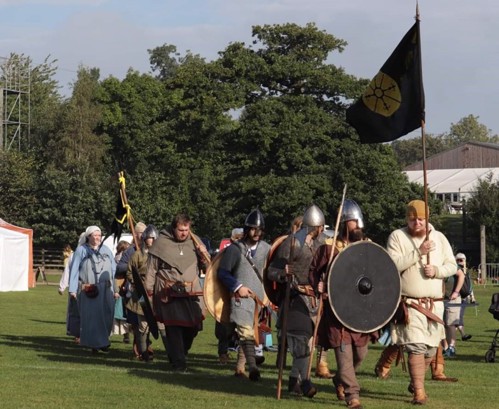The History
The Anglo-Saxon Kingdoms
After the Romans left Britain in the early 5th century CE, migrant settlers arrived from Northwest Europe including from the regions of Saxony and Angelia - the Anglo-Saxons. They gradually occupied the east of the country, but not the west - Devon, Cornwall and Wales remained largely unaffected.
Seven Anglo-Saxon kingdoms developed: Mercia, Northumbria, Wessex, East Anglia, Essex, Sussex and Kent. Much of the information we have about this period is from documents called the Anglo-Saxon Chronicle, initially by the chroniclers of King Alfred the Great, which describes events like important battles and information about kings and bishops.
The name Mercia comes from Old English ‘People of the Marches’. It became one of the largest of the Anglo-Saxon kingdoms stretching from the border with Wales to the North Sea coast in the east. The lands we now know as Herefordshire lay along the border or ‘marches’ between Mercia and Wales.

Mercia was at its most powerful under King Offa, who reigned 757-796. Continued unrest along the border with Wales led him to construct Offa’s Dyke as a defensive barrier against the Britons living in Wales.

The arrival of the Vikings
Around 790, while Offa was still on the throne of Mercia, the first Viking raids began with attacks on Portland (789), Lindisfarne (790) and Iona (794).
These raiders were skilled sailors and traders. Their home was in Scandinavia but they travelled by river and sea to Iceland, Greenland and eventually North America to the west and travelled and traded as far as Russia, Constantinople and Iraq to the east. Many different groups raided across the British Isles over many years, attacking in different places until they eventually began to settle.
Anglo-Saxon writers called them various names including Danes, Norsemen, Northmen, sea wolves or sea raiders. They were also called the heathen to distinguish them from the Anglo-Saxons who were Christians.
The early raids were short campaigns, with the Vikings looting treasure and capturing people who they made slaves. Monasteries were often targeted as they held treasures such a silver and gold plates, bowls, crucifixes and other precious objects. Sometimes they took loot by force but at other times they were given it as part of an agreement for them to go away. They returned to Scandinavia in winter.

The Great Viking Army
In 865 the Viking ‘Great Heathen Army’ landed in East Anglia. This marked a new phase as their leaders wanted to settle permanently and began to challenge the Anglo-Saxon kingdoms. They were successful in Northumbria, East Anglia and the eastern part of Mercia. In 866 they captured York and made it their capital and in 869 they killed Edmund, King of East Anglia.
The kings of Mercia and Wessex continued to resist. In 871 there were nine battles between Wessex and the Great Army. King Aethelred of Wessex died and was succeeded by his younger brother, Alfred the Great.
In 873 the Great Army overwintered close to the Mercian royal monastery at Repton. The Mercian King Burgred was forced to flee to Rome and Ceolwulf II became king.
By 874 the Great Army had split into two with one part going north and the other, under Guthrun, continuing south and west to harry Wessex and Mercia.
Introduction of Danelaw
In 878 an army led by Alfred defeated Guthrun and the Great Heathen Army at Edington in Somerset.
Under the treaty agreed between them the eastern kingdoms and a large part of Mercia came under Guthrun’s control in the Danelaw. The boundary is recorded as running ‘up the Thames and then up the Lea, and along the Lea to its source, then in a straight line to Bedford, then up the Ouse to Watling Street’. Guthrun converted to Christianity and after spending time at Cirencester, moved to East Anglia in 880.

The treaty meant that half of Mercia was lost to the Danelaw. Ceolwulf II mysteriously disappears from the historical record in 879 and Alfred's chroniclers wrote Ceolwulf II off as insignificant. He had no children and after his demise the remaining western half of Mercia came under the control of Lord Aethelred, under Alfred's overlordship. In the mid-880s Aethelred married Alfred's eldest daughter, Aethelflaed, further strengthening the ties between what was left of Mercia and Wessex
The formation of a united England
Conflict between the three remaining Anglo-Saxon kingdoms and the Vikings continued. In the 890s new Viking armies arrived prompting Alfred to create a standing army and a fleet of ships. He also set up a system of forts or burghs, within a day’s ride of each other, to improve the ability to defend against attack. Alfred’s successors, his son Edward and his daughter Aethelflaed, continued to fight against the Danes. In a series of campaigns in the 910s they conquered Danish territory in the Midlands and East Anglia. In 927 Edward captured York and in 937 his grandson Aethelstan defeated a combined army of Vikings and Scots at Brunanburh. Viking rule ended in 954 when Eric Bloodaxe was driven out of Northumbria.
What this means for Herefordshire Hoard
The Herefordshire Hoard was buried in 877-879 probably as a result of the movements and incursions of the Viking Great Army, either just before or just after the Battle of Edington in 878. The army camped at Gloucester and at Cirencester in 878-879 and the hoard may have been deposited around this time.

